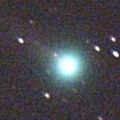
|
Now it is very bright as 6.8 mag (June 10, Michael Mattiazzo). It will approach to Sun down to 0.3 a.u. on July 3, and it is expected to brighten up to 2.5 mag. Now it is not observable. It will appear in the evening sky at 3-4 mag in mid July in the Northern Hemisphere, or at 5-6 mag in late July in the Southern Hemisphere. Then it stays observable while getting fainter.
Date(TT) R.A. (2000) Decl. Delta r Elong. m1 Best Time(A, h)
June 20 5 58.31 12 58.0 1.467 0.504 10 5.4 18:26 ( 98,-12)
June 27 5 55.23 20 40.1 1.346 0.361 7 3.7 5:38 (253,-11)
|
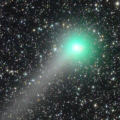
|
Now it is very bright as 6.2 mag (June 20, Marco Goiato). It will be fading after July. In the Southern Hemisphere, it stays observable in good condition for a long time after this. In the Northern Hemisphere, it will appear in the evening sky soon. Then it becomes observable in good condition.
Date(TT) R.A. (2000) Decl. Delta r Elong. m1 Best Time(A, h)
June 20 9 4.51 -10 55.3 0.858 0.914 57 5.4 18:26 (107, 40)
June 27 9 56.01 -5 33.5 0.828 0.926 59 5.4 18:28 (117, 41)
|
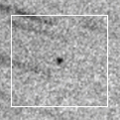
|
It will approach to Sun down to 0.34 a.u. and brighten up to 7 mag in June. In the Southern Hemisphere, it will appear in the evening sky at 7 mag in early July. Then it stays observable in good condition while the comet will be fading. In the Northern Hemisphere, it is not observable until mid August when the comet will fade down to 12 mag.
Date(TT) R.A. (2000) Decl. Delta r Elong. m1 Best Time(A, h)
June 20 6 35.56 24 51.7 1.336 0.372 9 7.9 18:26 (113,-11)
June 27 7 33.24 20 51.0 1.161 0.338 16 7.3 18:28 (113, -3)
|
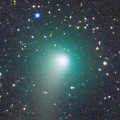
|
Now it is 9.2 mag (July 20, Marco Goiato). It stays bright as 8-9 mag until July. It is observable in good condition in the Northern Hemisphere. It will be observable after late June also in the Southern Hemisphere.
Date(TT) R.A. (2000) Decl. Delta r Elong. m1 Best Time(A, h)
June 20 12 3.73 50 25.2 1.718 1.730 73 8.4 18:26 (177, 5)
June 27 12 21.55 44 48.9 1.763 1.765 73 8.6 18:28 (175, 10)
|
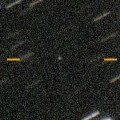
|
Now it is 15.5 mag (June 2, SONEAR Observatory, Oliveira). It was expected to brighten rapidly up to 9.5 mag in June. But actually, it is much fainter than expected. It has finally started brightening in late May. It is not observable in June. It will be observable in good condition after July while the comet will be fading.
Date(TT) R.A. (2000) Decl. Delta r Elong. m1 Best Time(A, h)
June 20 5 47.21 28 17.6 0.481 0.539 5 9.6 5:36 (248,-19)
June 27 5 8.71 28 58.2 0.577 0.500 17 9.5 5:38 (239, -7)
|

|
Recovered from SWAN images after 24-year blank. Now it is very bright as 10.2 mag (May 31, Marco Goiato). It stays 10-11 mag until August. In the Southern Hemisphere, it stays observable in the morning sky for a long time. In the Northern Hemisphere, it is too low to observe until July.
Date(TT) R.A. (2000) Decl. Delta r Elong. m1 Best Time(A, h)
June 20 3 2.96 11 12.7 1.973 1.406 42 10.2 5:36 (238, 22)
June 27 3 25.47 11 58.1 1.971 1.424 43 10.3 5:38 (236, 22)
|

|
It brightened up to 4.7 mag in early May (May 2, Marco Goiato). However, it is fading and getting diffused after that. It has already faded down to 7.3 mag (May 21, Mitsunori Tsumura). It is not observable until August after this.
Date(TT) R.A. (2000) Decl. Delta r Elong. m1 Best Time(A, h)
June 20 6 1.96 36 2.4 1.678 0.723 12 10.4 18:26 (119,-23)
June 27 6 11.24 32 56.8 1.834 0.852 10 11.3 5:38 (243,-21)
|
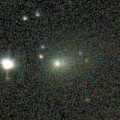
|
Now it is 11.6 mag (June 20, Marco Goiato). Brightening very rapidly. It will brighten up to 8-9 mag from summer to autumn. It will be observable in excellent condition in the Southern Hemisphere. It locates very low around the high light in the Northern Hemisphere.
Date(TT) R.A. (2000) Decl. Delta r Elong. m1 Best Time(A, h)
June 20 12 45.76 -3 46.4 1.168 1.713 103 11.5 18:50 (180, 59)
June 27 12 51.65 -4 50.8 1.189 1.672 98 11.2 18:29 (180, 60)
|
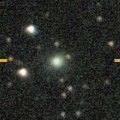
|
Now it is 14.6 mag (June 1, Thomas Lehmann). It will brighten up to 10.5 mag from 2020 December to 2021 January. In the Northern Hemisphere, it stays observable in good condition while the comet will be brightening gradually, but it is not observable at the high light. In the Southern Hemisphere, it is not observable for a long time, but it will be observable in good condition after the high light.
Date(TT) R.A. (2000) Decl. Delta r Elong. m1 Best Time(A, h)
June 20 11 59.47 62 21.3 2.854 2.680 69 13.1 18:26 (177, -7)
June 27 11 57.38 58 39.8 2.845 2.618 66 12.9 18:28 (173, -4)
|
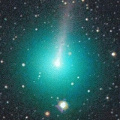
|
It brightened up to 8 mag from March to April. It continued brightening for a while even after the perihelion passage on Mar. 15. But it is fading now. It has already faded down to 13.5 mag (June 14, Paul Camilleri). It stays observable for a long time in the Northern Hemisphere. It is observable in the evening sky after this also in the Southern Hemisphere. It seems to be a fragment of C/1988 A1 (Liller), like C/1996 Q1 (Tabur) and C/2015 F3 (SWAN).
Date(TT) R.A. (2000) Decl. Delta r Elong. m1 Best Time(A, h)
June 20 11 56.81 30 42.7 1.743 1.837 78 13.3 18:26 (174, 24)
June 27 12 4.62 25 52.0 1.905 1.929 75 13.9 18:28 (168, 29)
|

|
Appearing in the morning sky. Now it is 14.9 mag (May 27, Slooh.com Canary Islands Observatory).
Date(TT) R.A. (2000) Decl. Delta r Elong. m1 Best Time(A, h)
June 20 2 25.35 23 13.7 6.441 5.808 47 13.8 5:36 (222, 18)
June 27 2 29.86 23 42.4 6.359 5.809 53 13.7 5:38 (217, 21)
|

|
Now it is 13.5 mag (May 17, Thomas Lehmann). It stays 14 mag until autumn. In the Southern Hemisphere, it will never be observable again.
Date(TT) R.A. (2000) Decl. Delta r Elong. m1 Best Time(A, h)
June 20 2 48.66 77 52.0 4.206 3.778 58 14.0 5:36 (190,-27)
June 27 3 17.86 80 5.3 4.218 3.814 60 14.1 5:38 (189,-28)
|
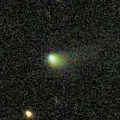
|
Now it is 14.0 mag (June 14, Paul Camilleri). It stays 13-14 mag from 2020 to 2021. It stays observable in good condition for a while.
Date(TT) R.A. (2000) Decl. Delta r Elong. m1 Best Time(A, h)
June 20 12 35.21 12 2.5 2.906 3.149 94 14.2 18:40 (180, 43)
June 27 12 38.54 10 56.8 2.984 3.134 88 14.2 18:28 (176, 44)
|
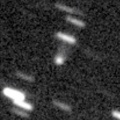
|
Now it is 15.0 mag (June 16, Toshihiko Ikemura, Hirohisa Sato). It will brighten up to 13 mag in 2021. In 2020, it is observable at 15 mag in good condition from spring to summer.
Date(TT) R.A. (2000) Decl. Delta r Elong. m1 Best Time(A, h)
June 20 13 56.51 -22 5.4 4.184 4.844 125 15.0 20:00 (180, 77)
June 27 13 53.87 -22 25.6 4.238 4.805 118 15.0 19:30 (180, 78)
|
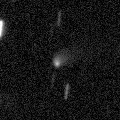
|
Now it is 15.5 mag (June 6, iTelescope Observatory, Siding Spring). It stays 14-15 mag until 2021. In the Southern Hemisphere, it stays observable in good condition for a long time. In the Northern Hemisphere, it is not observable until June in 2021.
Date(TT) R.A. (2000) Decl. Delta r Elong. m1 Best Time(A, h)
June 20 14 44.88 -83 55.1 4.333 4.885 117 15.1 20:51 ( 0, 41)
June 27 14 33.95 -83 22.4 4.316 4.860 116 15.0 20:12 ( 0, 42)
|
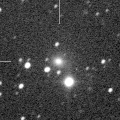
|
Now it is bright as 13.9 mag (Apr. 24, Chris Wyatt). It stays 15 mag until summer. It stays observable for a long time in the Southern Hemisphere. It is not observable until August in the Northern Hemisphere.
Date(TT) R.A. (2000) Decl. Delta r Elong. m1 Best Time(A, h)
June 20 3 14.24 -35 20.3 4.123 3.894 70 15.1 5:36 (287, 45)
June 27 3 17.73 -35 2.7 4.096 3.924 73 15.2 5:38 (285, 50)
|
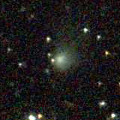
|
Now it is 15.4 mag (June 1, Thomas Lehmann). It is expected to be observable at 5-6 mag for a long time from 2022 to 2023. In the Northern Hemisphere, it is not observable at the high light from 2022 summer to 2023 summer. In the Southern Hemisphere, it is only visible in the extremely low sky in summer in 2020. But it will be observable in good condition at the high light.
Date(TT) R.A. (2000) Decl. Delta r Elong. m1 Best Time(A, h)
June 20 17 40.86 53 17.8 8.618 8.905 103 15.2 23:43 (180, 2)
June 27 17 35.67 53 4.7 8.572 8.854 102 15.1 23:11 (180, 2)
|

|
Now it is 15.1 mag (June 15, Toshihiko Ikemura, Hirohisa Sato). It stays 15-16 mag for a long time until 2021.
Date(TT) R.A. (2000) Decl. Delta r Elong. m1 Best Time(A, h)
June 20 20 17.89 13 50.0 3.766 4.475 128 15.4 2:25 (180, 41)
June 27 20 9.25 15 8.9 3.712 4.476 133 15.4 1:49 (180, 40)
|

|
Fragment of C/1844 Y1 (Great Comet). It brightened up to 7.0 mag in late March ((Mar. 30, Charles S. Morris). But the nucleus was split into some fragments, and it faded out after that. It was 9.1 mag in mid May (May 17, Sandor Szabo). It approached to Sun down to 0.25 a.u. on May 31. In the Northern Hemisphere, it is not observable after this. In the Southern Hemisphere, it appears in the morning sky in late June, but it locates extremely low.
Date(TT) R.A. (2000) Decl. Delta r Elong. m1 Best Time(A, h)
June 20 5 4.58 4 35.4 1.460 0.649 22 15.4 5:36 (262, 3)
June 27 5 27.95 3 41.6 1.627 0.810 23 16.6 5:38 (262, 4)
|
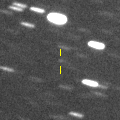
|
Now it is 16.3 mag (June 2, ATLAS-HKO, Haleakala). It will brighten up to 15-16 mag from June to August, and it will be observable in good condition.
Date(TT) R.A. (2000) Decl. Delta r Elong. m1 Best Time(A, h)
June 20 19 24.59 -0 59.3 1.149 2.085 148 15.6 1:32 (180, 56)
June 27 19 22.66 -0 51.0 1.117 2.076 153 15.5 1:02 (180, 56)
|

|
Now it is 16.4 mag (June 2, J. L. Virlichie, P. Traverse). It will brighten up to 13.5 mag in spring in 2021. In the Southern Hemisphere, it stays observable in good condition for a long time. In the Northern Hemisphere, it is not observable until spring in 2021.
Date(TT) R.A. (2000) Decl. Delta r Elong. m1 Best Time(A, h)
June 20 22 10.55 -59 10.7 3.711 4.352 123 15.7 4:18 ( 0, 66)
June 27 21 55.62 -61 3.5 3.614 4.314 127 15.6 3:36 ( 0, 64)
|

|
Now it is very faint as 18-19 mag (June 16, Alan Hale). It was expected to brighten very rapidly, and brighten up to 14.5 mag from August to September. But actually, it is much fainter than predicted. In the Northern Hemisphere, it stays observable for a long time, although it becomes extremely low in early September. In the Southern Hemisphere, it is not observable until late October.
Date(TT) R.A. (2000) Decl. Delta r Elong. m1 Best Time(A, h)
June 20 22 55.33 49 24.2 1.275 1.508 81 16.3 5:01 (180, 6)
June 27 23 5.93 59 19.8 1.201 1.424 79 15.9 4:44 (180, -4)
|

|
Now it is 15.3 mag (June 15, Toshihiko Ikemura, Hirohisa Sato). It will brighten up to 12 mag in winter in 2022. In the Northern Hemisphere, it stays observable in good condition for a long time. In the Southern Hemisphere, it is not observable until 2021 November.
Date(TT) R.A. (2000) Decl. Delta r Elong. m1 Best Time(A, h)
June 20 0 36.97 54 4.6 6.402 6.046 65 16.0 5:36 (190, 0)
June 27 0 41.45 55 7.4 6.297 6.002 68 16.0 5:38 (186, -1)
|

|
Now it is 16.4 mag (June 16, Toshihiko Ikemura, Hirohisa Sato). It will stay at 15 mag for a long time from 2021 to 2022. In the Northern Hemisphere, it stays observable in good condition while brightening gradually. In the Southern Hemisphere, it stays locating low for a long time.
Date(TT) R.A. (2000) Decl. Delta r Elong. m1 Best Time(A, h)
June 20 18 29.16 33 51.8 5.660 6.260 122 16.2 0:36 (180, 21)
June 27 18 22.13 33 23.4 5.613 6.230 123 16.2 0:02 (180, 22)
|
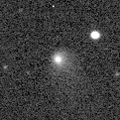
|
It brightened up to 13.8 mag in autumn in 2019 (Sept. 3, Chris Wyatt). Now it is fading slowly. Now it is 16.0 mag (June 4, ATLAS-MLO, Mauna Loa). In 2020, it stays observable in good condition while the comet will be fading from 16 to 17 mag.
Date(TT) R.A. (2000) Decl. Delta r Elong. m1 Best Time(A, h)
June 20 0 39.12 -1 31.3 5.831 5.751 80 16.3 5:36 (209, 53)
June 27 0 39.98 -1 1.7 5.759 5.791 86 16.4 5:38 (198, 55)
|
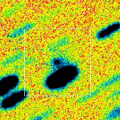
|
Now it is 18.6 mag (June 2, J. L. Virlichie, P. Traverse). It brightens up to 13.5 mag in winter. But it is not observable at high light. In the Southern Hemisphere, it stays observable in good condition until autumn when the comet will brighten up to 14 mag. It stays locating very low in the Northern Hemisphere. It is fainter than this ephemeris recently.
Date(TT) R.A. (2000) Decl. Delta r Elong. m1 Best Time(A, h)
June 20 18 38.43 -47 7.6 1.787 2.741 154 16.6 0:47 ( 0, 78)
June 27 18 30.20 -46 57.6 1.750 2.712 156 16.4 0:11 ( 0, 78)
|

|
It brightened up to 13.2 mag from spring to autumn in 2019 (June 30, Thomas Lehmann). Now it is fading slowly. It has already faded down to 16.3 mag (June 7, ATLAS-MLO, Mauna Loa). In the Southern Hemisphere, it stays observable for a long time. In the Northern Hemisphere, it stays low for a long time.
Date(TT) R.A. (2000) Decl. Delta r Elong. m1 Best Time(A, h)
June 20 0 10.46 -30 12.9 3.920 4.191 98 16.5 5:36 (243, 80)
June 27 0 8.44 -30 14.0 3.856 4.230 104 16.5 5:38 (203, 85)
|

|
Now it is 15.6 mag (May 22, ATLAS-MLO, Mauna Loa). It is observable at 16 mag in 2020. It is observable in excellent condition in the Southern Hemisphere. It locates somewhat low in the Northern Hemisphere.
Date(TT) R.A. (2000) Decl. Delta r Elong. m1 Best Time(A, h)
June 20 19 19.33 -29 36.6 5.731 6.695 160 16.6 1:27 (180, 85)
June 27 19 11.50 -29 28.7 5.712 6.709 167 16.6 0:52 (180, 84)
|

|
Now it is 16.8 mag (May 28, Toshihiko Ikemura, Hirohisa Sato). It will be observable at 16.5-17 mag from spring in 2020 to summer in 2021.
Date(TT) R.A. (2000) Decl. Delta r Elong. m1 Best Time(A, h)
June 20 18 56.49 23 26.3 4.034 4.760 130 16.7 1:04 (180, 32)
June 27 18 45.82 22 49.5 3.990 4.748 133 16.6 0:26 (180, 32)
|

|
Now it is 17.1 mag (May 19, ATLAS-MLO, Mauna Loa). It will brighten up to 16.5 mag and will be observable in good condition from June to October.
Date(TT) R.A. (2000) Decl. Delta r Elong. m1 Best Time(A, h)
June 20 20 35.99 13 53.4 1.482 2.234 125 16.8 2:43 (180, 41)
June 27 20 35.86 15 6.9 1.426 2.220 129 16.7 2:15 (180, 40)
|
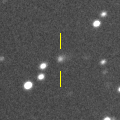
|
Now it is 16.8 mag (June 10, ATLAS-HKO, Haleakala). It stays observable at 16-17 mag from 2020 to 2021. It locates somewhat low in the Northern Hemisphere.
Date(TT) R.A. (2000) Decl. Delta r Elong. m1 Best Time(A, h)
June 20 10 55.76 -15 34.2 6.632 6.588 83 16.8 18:26 (130, 63)
June 27 10 59.37 -15 17.8 6.735 6.591 77 16.8 18:28 (121, 58)
|
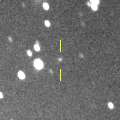
|
Now it is 17.4 mag (May 9, P. Camilleri, H. Williams, J. Oey). It is expected to brighten up to 13 mag in 2022. In 2020, it is observable in excellent condition in the Southern Hemisphere. In the Northern Hemisphere, it is not observable. It will be observable from autumn to winter, but it locating extremely low.
Date(TT) R.A. (2000) Decl. Delta r Elong. m1 Best Time(A, h)
June 20 6 57.28 -25 25.6 7.668 7.075 51 16.9 18:26 ( 73, 21)
June 27 7 2.68 -25 22.4 7.651 7.035 49 16.9 18:28 ( 70, 17)
|
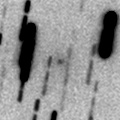
|
Now it is 17.3 mag (June 15, Toshihiko Ikemura, Hirohisa Sato). It brightens up to 17 mag from June to July. It is observable in excellent condition in the Northern Hemisphere. In the Southern Hemisphere, it is not observable until August.
Date(TT) R.A. (2000) Decl. Delta r Elong. m1 Best Time(A, h)
June 20 23 4.12 56 32.7 1.504 1.619 77 17.0 5:11 (180, -2)
June 27 22 13.78 62 18.3 1.413 1.638 83 16.9 3:54 (180, -7)
|

|
Now it is 17.6 mag (June 16, Toshihiko Ikemura, Hirohisa Sato). Small comet. But it will approach to Sun down to 0.47 a.u. in September, and it is expected to brighten up to 11 mag. It stays observable in good condition until late August while the comet will be brightening up to 11 mag.
Date(TT) R.A. (2000) Decl. Delta r Elong. m1 Best Time(A, h)
June 20 23 39.52 21 21.3 1.573 1.797 85 17.5 5:36 (183, 34)
June 27 23 57.01 23 13.6 1.405 1.687 86 17.0 5:35 (180, 32)
|

|
Now it is 17.7 mag (June 13, J. L. Virlichie, P. Traverse). It brightens up to 16 mag from summer to winter. In the Southern Hemisphere, it is observable in excellent condition. In the Northern Hemisphere, it is not observable until late October.
Date(TT) R.A. (2000) Decl. Delta r Elong. m1 Best Time(A, h)
June 20 22 14.34 -57 54.2 1.460 2.186 122 17.3 4:21 ( 0, 67)
June 27 22 21.71 -59 45.1 1.383 2.138 125 17.1 4:01 ( 0, 65)
|

|
It brightened up to 13.2 mag from April to May (Apr. 28, Alan Hale). Now it is fading rapidly. It has already faded down to 17.8 mag (June 8, Hidetaka Sato). It will be fainter than 18 mag soon. It is not observable in the Southern Hemisphere.
Date(TT) R.A. (2000) Decl. Delta r Elong. m1 Best Time(A, h)
June 20 9 19.24 55 45.5 1.676 1.271 49 17.2 18:26 (156, -8)
June 27 9 27.63 52 34.2 1.867 1.361 45 17.7 18:28 (152, -8)
|
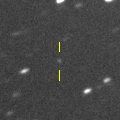
|
Now it is 17.7 mag (May 26, ATLAS-MLO, Mauna Loa). It stays observable at 16-17 mag for a long time until 2024.
Date(TT) R.A. (2000) Decl. Delta r Elong. m1 Best Time(A, h)
June 20 15 40.35 -16 6.3 8.958 9.830 147 17.2 21:44 (180, 71)
June 27 15 36.64 -15 49.6 9.013 9.813 139 17.2 21:13 (180, 71)
|

|
It brightened up to 12-13 mag from 2018 to 2019. Now it is fading. It has already faded down to 17.1 mag (June 2, J. L. Virlichie, P. Traverse). In the Southern Hemisphere, it stays observable in good condition for a long time. It will never be observable after this in the Northern Hemisphere.
Date(TT) R.A. (2000) Decl. Delta r Elong. m1 Best Time(A, h)
June 20 9 17.71 -59 50.1 5.530 5.674 92 17.3 18:26 ( 35, 51)
June 27 9 20.56 -58 55.9 5.631 5.721 89 17.3 18:28 ( 38, 48)
|
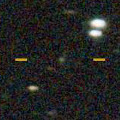
|
Now it is 17.1 mag (June 10, ATLAS-HKO, Haleakala). It became brighter than orignally predicted. It stays observable at 17 mag in good condition until autumn.
Date(TT) R.A. (2000) Decl. Delta r Elong. m1 Best Time(A, h)
June 20 12 48.96 -9 25.6 1.676 2.187 106 17.3 18:54 (180, 65)
June 27 12 54.90 -10 13.7 1.734 2.172 101 17.3 18:32 (180, 65)
|

|
It will pass the perihelion in 2021, and it is predicted to be observable at 17-18 mag from 2020 to 2022. However, it has not been observed at all since 2015. It was not detected, fainter than 20.5 mag, in 2017 May (Werner Hasubick).
Date(TT) R.A. (2000) Decl. Delta r Elong. m1 Best Time(A, h)
June 20 20 39.01 -21 56.6 5.158 5.994 142 17.3 2:46 (180, 77)
June 27 20 37.31 -22 0.9 5.085 5.982 149 17.3 2:17 (180, 77)
|
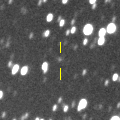
|
Now it is 17.3 mag (Apr. 23, D. Buczynski). It will be observable at 16.5-17 mag from 2020 to 2021. In the Southern Hemisphere, it is not observable until summer in 2021.
Date(TT) R.A. (2000) Decl. Delta r Elong. m1 Best Time(A, h)
June 20 2 5.02 69 24.1 6.707 6.212 56 17.4 5:36 (193,-18)
June 27 2 4.95 69 59.2 6.650 6.198 59 17.4 5:38 (191,-18)
|

|
Now it is 17.8 mag (June 14, Charles S. Morris). It will fade out after this, and will be fainter than 18 mag in July.
Date(TT) R.A. (2000) Decl. Delta r Elong. m1 Best Time(A, h)
June 20 12 59.56 -3 55.0 1.599 2.122 106 17.4 19:04 (180, 59)
June 27 13 7.39 -4 42.5 1.676 2.130 101 17.5 18:45 (180, 60)
|
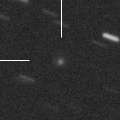
|
It brigthened up to 16.5 mag in May (May 14, R. Ligustir). It is fading rapidly after that. It has already faded down to 18.8 mag (June 16, Toshihiko Ikemura, Hirohisa Sato).
Date(TT) R.A. (2000) Decl. Delta r Elong. m1 Best Time(A, h)
June 20 15 0.99 0 9.9 2.971 3.725 131 17.5 21:05 (180, 55)
June 27 14 58.43 -0 48.0 3.081 3.761 125 17.6 20:35 (180, 56)
|

|
Now it is 17.1 mag (May 30, ATLAS-MLO, Mauna Loa). It will brighten up to 15.5 mag in early 2021. In 2020, it stays observable at 17 mag until November in the Southern Hemisphere, or until July in the Northern Hemisphere.
Date(TT) R.A. (2000) Decl. Delta r Elong. m1 Best Time(A, h)
June 20 14 0.36 -30 30.6 2.511 3.236 127 17.6 20:04 (180, 86)
June 27 13 58.50 -30 0.8 2.534 3.181 121 17.6 19:35 (180, 85)
|
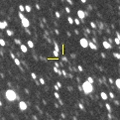
|
Now it is 19.9 mag (May 29, Toshihiko Ikemura, Hirohisa Sato). It stays observable at 18 mag for a long time from 2019 to 2021. However, it is much fainter than this ephemeris recently.
Date(TT) R.A. (2000) Decl. Delta r Elong. m1 Best Time(A, h)
June 20 18 59.72 -19 58.3 6.714 7.698 164 17.6 1:07 (180, 75)
June 27 18 56.03 -20 34.4 6.693 7.701 172 17.6 0:36 (180, 76)
|

|
Now it is 17.6 mag (May 28, Hiroshi Abe). It will be fading slowly after this. It is observable in good condition in the Northern Hemisphere. In the Southern Hemisphere, it is observable in the extremely low sky only in 2021 spring.
Date(TT) R.A. (2000) Decl. Delta r Elong. m1 Best Time(A, h)
June 20 12 37.12 49 29.7 9.045 8.904 78 17.6 18:41 (180, 6)
June 27 12 37.65 48 37.5 9.129 8.917 74 17.7 18:28 (178, 6)
|
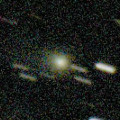
|
It brightened up to 10.8 mag (Apr. 20, Sandor Szabo). Fading very rapidly. It has already fadeod dow to 15.8 mag (June 13, ATLAS-MLO, Mauna Loa). It will be fainter than 18 mag soon.
Date(TT) R.A. (2000) Decl. Delta r Elong. m1 Best Time(A, h)
June 20 10 30.05 19 27.1 1.545 1.421 63 17.8 18:26 (150, 30)
June 27 10 53.84 16 52.6 1.672 1.514 63 18.4 18:28 (147, 32)
|
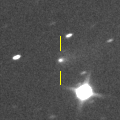
|
It brightened up to 15.9 mag in spring (Mar. 17, Purple Mountain Observatory, XuYi Station). Now it is fading. It has already faded down to 17.1 mag (May 23, ATLAS-MLO, Mauna Loa). It will be fainter than 18 mag in late June.
Date(TT) R.A. (2000) Decl. Delta r Elong. m1 Best Time(A, h)
June 20 13 12.92 -3 26.2 1.810 2.349 109 17.8 19:17 (180, 59)
June 27 13 18.55 -4 22.9 1.906 2.370 104 17.9 18:56 (180, 60)
|
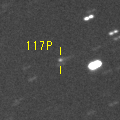
|
Now it is 17.8 mag (June 16, Toshihiko Ikemura, Hirohisa Sato). It will brighten up to 13 mag in 2022. It will be unobservable temporarily in August.
Date(TT) R.A. (2000) Decl. Delta r Elong. m1 Best Time(A, h)
June 20 10 28.21 17 55.4 4.684 4.328 63 17.8 18:26 (148, 31)
June 27 10 33.05 17 16.2 4.761 4.314 58 17.8 18:28 (142, 28)
|
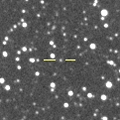
|
Now it is 17.1 mag (May 24, ATLAS-MLO, Mauna Loa). It is observable at 17-18 mag in good condition in 2020 summer.
Date(TT) R.A. (2000) Decl. Delta r Elong. m1 Best Time(A, h)
June 20 19 43.52 30 11.7 8.391 8.948 120 17.8 1:50 (180, 25)
June 27 19 39.72 30 43.9 8.347 8.941 122 17.8 1:19 (180, 24)
|
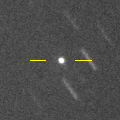
|
It brightened up to 15.9 mag from February to March (Feb. 18, Toshihiko Ikemura, Hirohisa Sato). Now it is fading. It has already faded down to 18.0 mag (May 31, P. Camilleri, H. Williams). It will be fainter than 18 mag in late June.
Date(TT) R.A. (2000) Decl. Delta r Elong. m1 Best Time(A, h)
June 20 11 0.73 -14 50.6 1.506 1.725 83 17.9 18:26 (133, 63)
June 27 11 12.47 -17 16.5 1.581 1.745 81 18.0 18:28 (122, 62)
|

|
Now it is 17.7 mag (June 17, Taras Prystavski). Taras Prystavski detected its cometary activity. It will brighten up to 15.5 mag from spring to summer in 2021. In the Southern Hemisphere, it stays observable in excellent condition for a long time. In the Northern Hemisphere, it is observable in good condition in 2020, however, it will be unobservable in 2021.
Date(TT) R.A. (2000) Decl. Delta r Elong. m1 Best Time(A, h)
June 20 23 22.22 9 54.9 3.880 4.070 93 18.0 5:29 (180, 45)
June 27 23 21.42 9 14.0 3.709 4.020 100 17.9 5:00 (180, 46)
|

|
Now it is 18.6 mag (May 30, ATLAS-MLO, Mauna Loa). It stays 18-19 mag for a long time from 2018 to 2020.
Date(TT) R.A. (2000) Decl. Delta r Elong. m1 Best Time(A, h)
June 20 21 3.04 -34 34.1 3.737 4.541 137 17.9 3:10 (180, 89)
June 27 20 59.66 -34 40.0 3.681 4.546 144 17.9 2:39 (180, 90)
|
|
![]()
 C/2020 H4 ( Leonard )
C/2020 H4 ( Leonard ) C/2019 L3 ( ATLAS )
C/2019 L3 ( ATLAS ) C/2018 U1 ( Lemmon )
C/2018 U1 ( Lemmon ) C/2017 B3 ( LINEAR )
C/2017 B3 ( LINEAR ) 17P/Holmes
17P/Holmes C/2018 A6 ( Gibbs )
C/2018 A6 ( Gibbs ) C/2017 U7 ( PanSTARRS )
C/2017 U7 ( PanSTARRS ) C/2017 Y2 ( PanSTARRS )
C/2017 Y2 ( PanSTARRS ) 257P/Catalina
257P/Catalina C/2019 C1 ( ATLAS )
C/2019 C1 ( ATLAS ) C/2019 T4 ( ATLAS )
C/2019 T4 ( ATLAS ) C/2020 K3 ( Leonard )
C/2020 K3 ( Leonard ) C/2020 K8 ( Catalina-ATLAS )
C/2020 K8 ( Catalina-ATLAS ) 162P/Siding Spring
162P/Siding Spring C/2020 H2 ( Pruyne )
C/2020 H2 ( Pruyne ) C/2020 F2 ( ATLAS )
C/2020 F2 ( ATLAS ) C/2017 M4 ( ATLAS )
C/2017 M4 ( ATLAS ) 278P/McNaught
278P/McNaught C/2014 F3 ( Sheppard-Trujillo )
C/2014 F3 ( Sheppard-Trujillo ) C/2019 T3 ( ATLAS )
C/2019 T3 ( ATLAS ) 87P/Bus
87P/Bus P/2019 LM4 ( Palomar )
P/2019 LM4 ( Palomar ) 28P/Neujmin 1
28P/Neujmin 1 C/2017 K5 ( PanSTARRS )
C/2017 K5 ( PanSTARRS ) C/2010 U3 ( Boattini )
C/2010 U3 ( Boattini ) 210P/Christensen
210P/Christensen P/2019 Y2 ( Fuls )
P/2019 Y2 ( Fuls ) 117P/Helin-Roman-Alu 1
117P/Helin-Roman-Alu 1 A/2019 O3
A/2019 O3 124P/Mrkos
124P/Mrkos A/2019 T2
A/2019 T2 186P/Garradd
186P/Garradd![]()












































